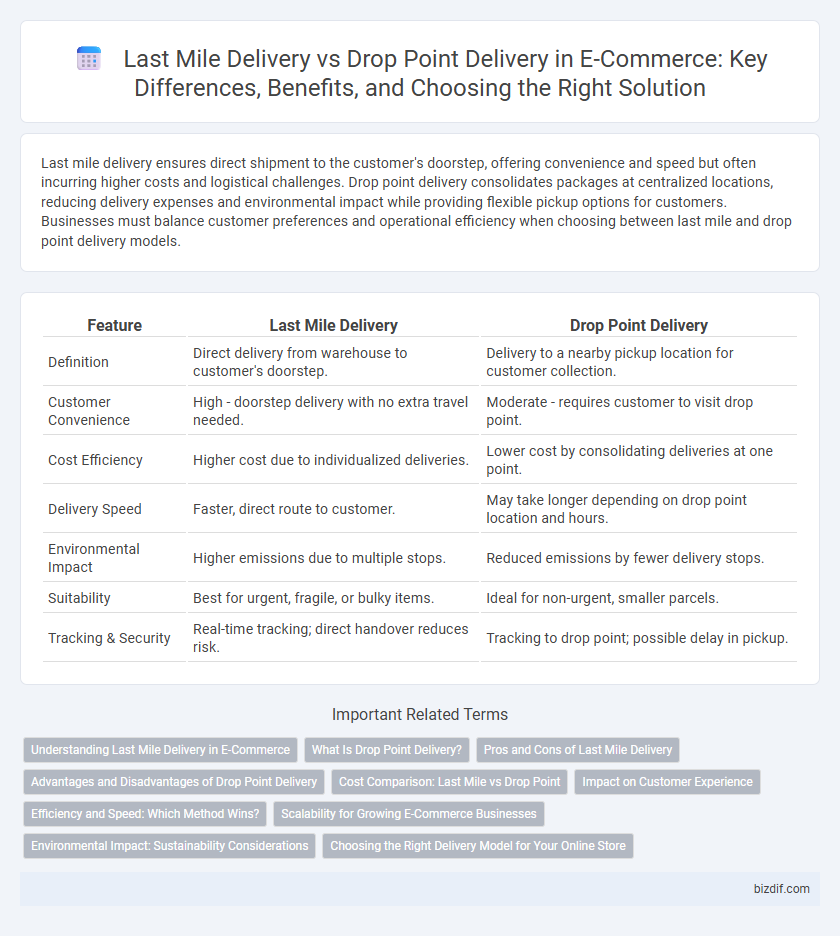Last mile delivery ensures direct shipment to the customer's doorstep, offering convenience and speed but often incurring higher costs and logistical challenges. Drop point delivery consolidates packages at centralized locations, reducing delivery expenses and environmental impact while providing flexible pickup options for customers. Businesses must balance customer preferences and operational efficiency when choosing between last mile and drop point delivery models.
Table of Comparison
| Feature | Last Mile Delivery | Drop Point Delivery |
|---|---|---|
| Definition | Direct delivery from warehouse to customer's doorstep. | Delivery to a nearby pickup location for customer collection. |
| Customer Convenience | High - doorstep delivery with no extra travel needed. | Moderate - requires customer to visit drop point. |
| Cost Efficiency | Higher cost due to individualized deliveries. | Lower cost by consolidating deliveries at one point. |
| Delivery Speed | Faster, direct route to customer. | May take longer depending on drop point location and hours. |
| Environmental Impact | Higher emissions due to multiple stops. | Reduced emissions by fewer delivery stops. |
| Suitability | Best for urgent, fragile, or bulky items. | Ideal for non-urgent, smaller parcels. |
| Tracking & Security | Real-time tracking; direct handover reduces risk. | Tracking to drop point; possible delay in pickup. |
Understanding Last Mile Delivery in E-Commerce
Last mile delivery in e-commerce refers to the final step of the shipping process where products are transported from a local distribution center directly to the customer's doorstep, significantly impacting customer satisfaction and operational costs. This stage often involves challenges such as traffic congestion, failed delivery attempts, and the need for efficient route optimization to ensure timely delivery. Innovations like real-time tracking, autonomous vehicles, and localized micro-fulfillment centers enhance last mile delivery efficiency, reducing delivery times and improving overall service quality.
What Is Drop Point Delivery?
Drop Point Delivery is a shipping method where packages are sent to a designated local collection hub or locker instead of directly to the customer's address. This approach enhances delivery efficiency by consolidating deliveries in a single location, reducing failed delivery attempts and lowering shipping costs for e-commerce retailers. Drop Point Delivery is increasingly popular in urban areas where customers prefer convenient pick-up options over home deliveries.
Pros and Cons of Last Mile Delivery
Last mile delivery ensures direct and fast shipping to the customer's doorstep, enhancing convenience and satisfaction but often incurs high operational costs and logistical complexities. It offers real-time tracking and personalized service, yet faces challenges such as traffic congestion, delivery failures, and increased carbon emissions. Businesses must balance the benefits of speed and customer experience against the expenses and environmental impact inherent in last mile logistics.
Advantages and Disadvantages of Drop Point Delivery
Drop Point Delivery offers cost-effective and efficient options by consolidating multiple packages at a single location, reducing last mile delivery expenses and carbon emissions. It provides convenience for customers through flexible pickup times but may introduce delays and less personalized service compared to direct home delivery. The trade-off involves balancing lower delivery costs and environmental benefits against potential reduced customer satisfaction and accessibility challenges.
Cost Comparison: Last Mile vs Drop Point
Last mile delivery incurs higher costs due to individualized drop-offs, increased fuel consumption, and longer driver hours, often accounting for up to 53% of total shipping expenses. Drop point delivery reduces expenses by consolidating multiple orders at centralized locations, minimizing delivery routes and enabling bulk shipments that lower per-package costs by approximately 20-40%. Businesses leveraging drop point delivery experience improved cost efficiency without compromising customer accessibility and convenience.
Impact on Customer Experience
Last mile delivery offers customers the convenience of direct home delivery, enhancing satisfaction through timely and personalized service. Drop point delivery provides increased flexibility by allowing customers to collect packages at nearby trusted locations, reducing missed deliveries and improving accessibility. Both methods significantly impact customer experience by balancing convenience, reliability, and security in the final delivery stage.
Efficiency and Speed: Which Method Wins?
Last Mile Delivery offers superior speed by ensuring parcels reach customers' doorsteps directly, reducing transit times and enhancing convenience. Drop Point Delivery boosts efficiency by consolidating shipments to centralized locations, minimizing delivery attempts and operational costs. E-commerce businesses prioritize Last Mile Delivery when speed is critical, while Drop Point Delivery suits high-volume areas emphasizing cost-effectiveness and resource optimization.
Scalability for Growing E-Commerce Businesses
Last mile delivery offers direct-to-consumer service ensuring fast, personalized shipments but faces challenges in scalability due to high operational costs and complex logistics in expanding urban areas. Drop point delivery enhances scalability for growing e-commerce businesses by consolidating shipments to centralized locations, reducing last mile expenses and improving delivery efficiency across wider geographic zones. Leveraging drop point networks supports scalable growth with optimized routing and cost-effective parcel handling, crucial for meeting increasing order volumes without compromising customer satisfaction.
Environmental Impact: Sustainability Considerations
Last Mile Delivery typically generates higher carbon emissions due to multiple stops and direct home deliveries, increasing fuel consumption and traffic congestion. Drop Point Delivery reduces environmental impact by consolidating parcels at centralized locations, leading to fewer delivery trips and lower overall emissions. This sustainable approach supports urban mobility goals and promotes efficiency in the e-commerce supply chain.
Choosing the Right Delivery Model for Your Online Store
Selecting the optimal delivery model for your online store hinges on factors like customer convenience, cost efficiency, and geographic reach. Last mile delivery offers direct-to-door service, enhancing customer satisfaction through faster, personalized shipping but often incurs higher logistics costs. Drop point delivery consolidates shipments to centralized locations, reducing expenses and delivery failures while encouraging customer pick-up flexibility, making it ideal for dense urban areas or cost-sensitive operations.
Last Mile Delivery vs Drop Point Delivery Infographic

 bizdif.com
bizdif.com